
Kalmia latifolia, the mountain laurel, calico-bush, or spoonwood, is a species of flowering plant in the heath family Ericaceae, that is native to the eastern United States. Its range stretches from southern Maine south to northern Florida, and west to Indiana and Louisiana. Mountain laurel is the state flower of Connecticut and Pennsylvania. It is the namesake of Laurel County in Kentucky, the city of Laurel, Mississippi, and the Laurel Highlands in southwestern Pennsylvania.
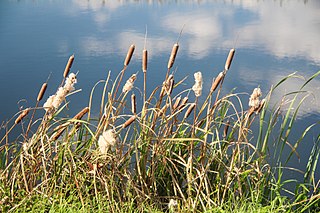
Typha latifolia, better known as broadleaf cattail, is a perennial herbaceous plant in the genus Typha. It is found as a native plant species in North and South America, Eurasia, and Africa.

Sagittaria latifolia is a plant found in shallow wetlands and is sometimes known as broadleaf arrowhead, duck-potato, Indian potato, or wapato. This plant produces edible tubers that have traditionally been extensively used by Native Americans.

Fraxinus latifolia, the Oregon ash, is a member of the ash genus Fraxinus, native to western North America.
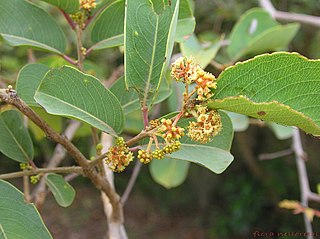
Anogeissus latifolia is a species of small to medium-sized tree native to the India, Nepal, Myanmar, and Sri Lanka. Its common names are axlewood (English), bakli, baajhi, dhau, dhawa, dhawra, or dhaora (Hindi), takhian-nu (Thai), and raam (Vietnamese).

Silene latifolia the white campion is a dioecious flowering plant in the family Caryophyllaceae, native to most of Europe, Western Asia and Northern Africa. It is a herbaceous annual, occasionally biennial or a short-lived perennial plant, growing to between 40–80 centimetres tall. It is also known in the US as bladder campion but should not be confused with Silene vulgaris, which is more generally called bladder campion.
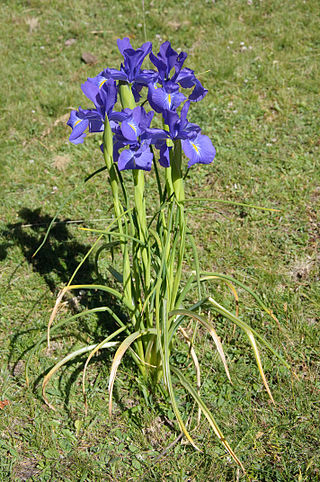
Iris latifolia, the English iris, also known as I. xiphiodes and I. anglica, is a hardy flowering bulbous species of the iris genus, in the family Iridaceae. It is native to the Pyrenees of Southwestern France and Northwestern Spain. It is widely cultivated in temperate regions for its purple flowers which appear in early Summer.

Campanula latifolia, the giant bellflower, is a species of bellflower in the family Campanulaceae. It is also known as the large campanula and the wide-leaved bellflower. It is native to Europe and western Asia and is widely grown as an ornamental plant.
The Wych Elm cultivar Ulmus glabra 'Albo-Variegata' was first mentioned by Weston in 1770 as U. glabra var. variegata. An U. campestris latifolia albo-variegataHort. was distributed by the Späth nursery, Berlin, from the 1890s to the 1930s.
The Wych elm cultivar Ulmus glabra 'Latifolia Aureo-Variegata' was first mentioned by Neubert in Deutsches Magazin für Garten- und Blumenkunde 1871 as Ulmus campestrisL.latifolia aureo-variegata.
The Wych Elm cultivar Ulmus glabra 'Latifolia Aurea' was listed by Schelle in Beissner et al, Handbuch der Laubholz-Benennung (1903), as Ulmus glabraMillerlatifolia aurea, but without description. In the Netherlands in the late 19th and early 20th centuries, however, Ulmus montana latifolia aurea was a synonym of the wych cultivar 'Lutescens', and Green reclassified Schelle's 'Latifolia aurea' as a form of U. glabraHudson.
The putative Wych Elm cultivar Ulmus glabra 'Latifolia Nigricans' was first described, as Ulmus campestris latifolia nigricans, by Pynaert in 1879. Pynaert, however, did not specify what species he meant by U. campestris. The tree was supplied by the Späth nursery of Berlin in the late 19th century and early 20th as Ulmus montana latifolia nigricans. Späth, like many of his contemporaries, used U. montana both for Wych Elm cultivars and for those of the U. × hollandica group.
The elm cultivar Ulmus 'Hertfordensis Latifolia' was mentioned by Boulger in Gardener's Chronicle II. 12: 298 1879, but without description.

The putative Wych Elm cultivar Ulmus glabra 'Latifolia' was identified in Audibert's Tonelle (1817) as U. campestrisLinn. [ = U. glabraHuds.] latifolia. The tree is reputed to have originated circa 1750 in or around Mechelen, and to have been widely planted throughout Belgium. A 1912 herbarium specimen from Oudenbosch, however, shows a hybrid leaf labelled Ulmus hollandica latifolia.

Chungtia is an Ao Naga village in Nagaland, India. It lies in the Ongpangkong range and is located 16 km north-west of Mokokchung. The Mokokchung-Mariani Highway passes through its eastern corner. It is located at an altitude of 3,362 feet (1,025 m) above sea level.

Madhuca longifolia is an Indian tropical tree found largely in the central, southern, north Indian plains and forests, Nepal, Myanmar and Sri Lanka. It is commonly known as madhūka, madkam, mahuwa, Butter Tree, mahua, mahwa, mohulo, Iluppai, Mee or vippa chettu. It is a fast-growing tree that grows to approximately 20 meters in height, possesses evergreen or semi-evergreen foliage, and belongs to the family Sapotaceae. It is adaptable to arid environments, being a prominent tree in tropical mixed deciduous forests in India in the states of Odisha, Chhattisgarh, Jharkhand, Uttar Pradesh, Bihar, Maharashtra, Andhra Pradesh, Madhya Pradesh, Kerala, Gujarat, West Bengal and Tamil Nadu.
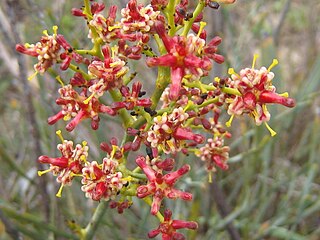
Stirlingia, commonly known as blueboy, is a genus of 7 species in the family Proteaceae, all of which are endemic to Western Australia.
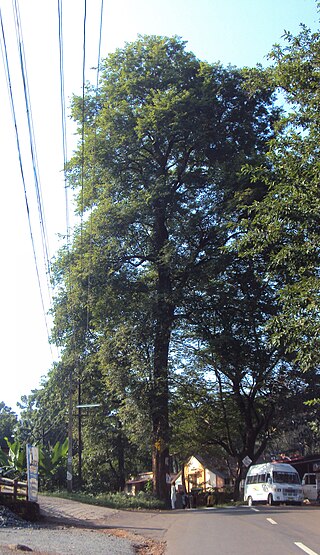
Dalbergia latifolia is a premier timber species, also known as the Indian rosewood. It is native to low-elevation tropical monsoon forests of south east India. Some common names in English include rosewood, Bombay blackwood, roseta rosewood, East Indian rosewood, reddish-brown rosewood, Indian palisandre, and Java palisandre. Its Indian common names are beete, and satisal. The tree grows to 40 metres (130 ft) in height and is evergreen, but locally deciduous in drier subpopulations.

Olyra latifolia, commonly known as carrycillo, is a species of bamboo in the grass family Poaceae. It occurs in Mexico, Central and South America, and in sub-Saharan Africa. It is a common species, up to 5 m (16 ft) tall, growing prolifically in rainforests, particularly near the margins.
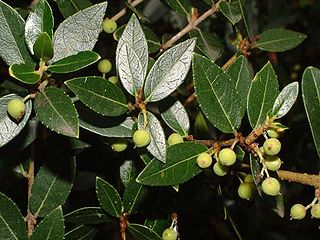
Phillyrea latifolia, commonly known as green olive tree or mock privet, is a species of tree in the family Oleaceae. It is native to the Mediterranean Basin, from Morocco and Portugal in the west, to the Levant in the east.















